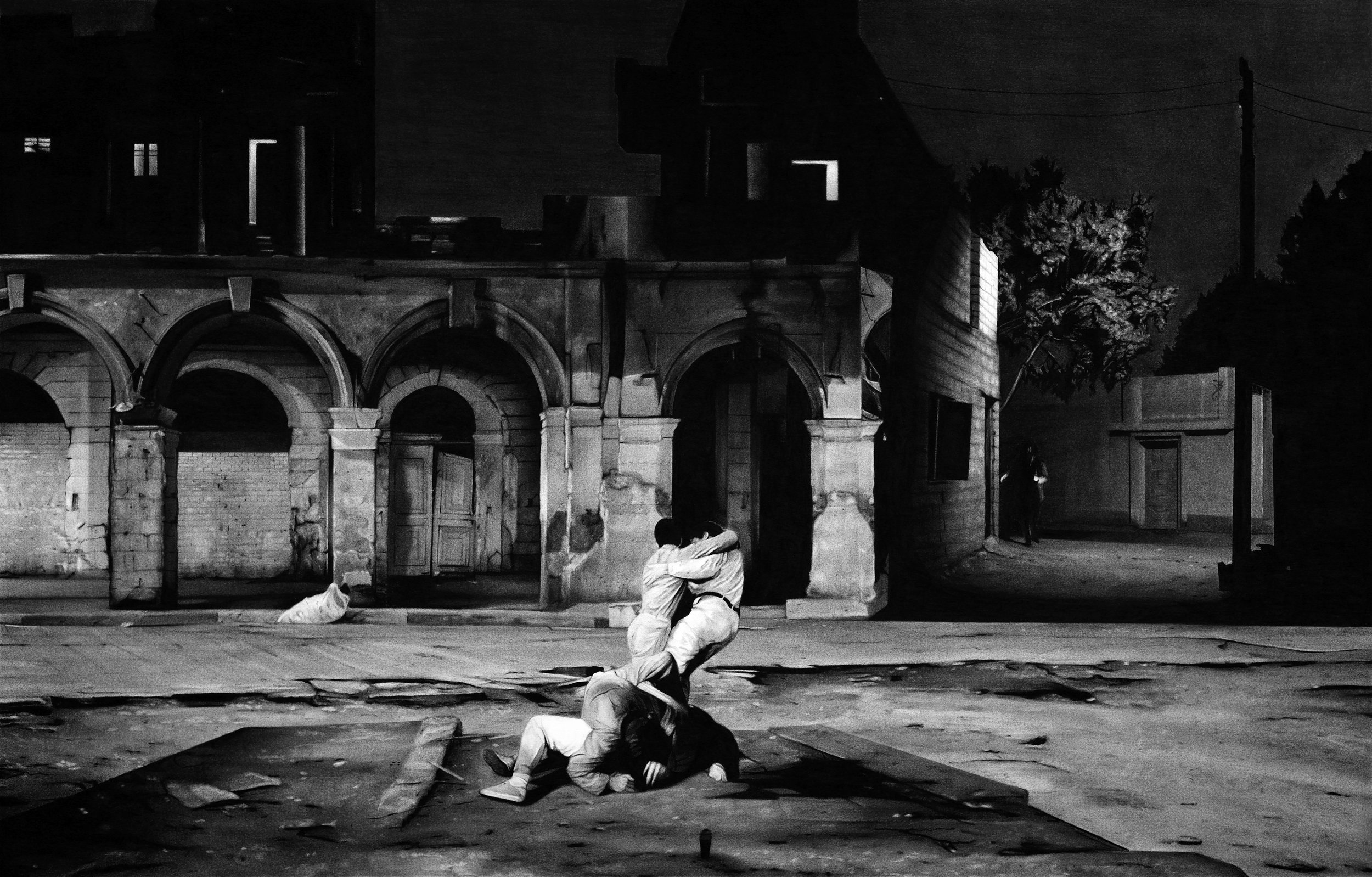“Mathieu Dufois”
Un élément absent d’une œuvre peut-il avoir une valeur aussi décisive que ce qui est sous nos yeux ? Le hors-cadre fait-il, lui aussi, le tableau ? À qui appartiennent ces ombres projetées sur le dos d’une femme accoudée à une porte fenêtre ? Dans son œuvre, Mathieu Dufois interpelle les angles morts et étend leurs ombres sur le visible. Des personnages semblent rôder autour du cadre sans pour autant oser y pénétrer.
Et le spectateur s’y perd, comme dans un labyrinthe où le réel se mélange au fictif, le vrai au rêve, l’ordinaire à l’inquiétant. Les temporalités tissent des liens entre elles, se confondent et deviennent floues : cette scène se déroule-t-elle vraiment sous nos yeux ou n’est-elle que la persistance rétinienne d’un souvenir passé ? Avec ses dessins, l’artiste mène une fouille archéologique dans la mémoire individuelle et collective. Il trace inlassablement les trajectoires d’ombres et de lumières, nous invitant –nous, spectateurs de son travail –dans une dimension qui ne semble exister que sous sa pierre noire. Où la scène de Dédale 04 se joue-t-elle ? Au premier plan, des corps s’affrontent et se fondent les uns dans les autres tandis qu’à l’arrière-plan une architecture nous plonge dans une ambiance proche du giallo italien.
C’est là, d’ailleurs, toute la qualité du travail de Mathieu Dufois : il soulève des questions, réveille notre imaginaire, nos références cinématographiques sans pour autant donner d’indications définitives. La cinéphilie de l’artiste se faufile partout dans ses dessins et nous amène dans un univers parcellaire. Mathieu Dufois nous invite à nous intéresser à la bride d’une pellicule, nous force a faire un arrêt sur image, mais où résonne insidieusement la scène précédente et celle à venir. Et les silhouettes, les ombres, les personnages anonymes qu’il dévoile dans un jeu dramatique de clair-obscur agissent comme des fantômes. Les fantômes d’une image qui s’ancre en nous, laisse une trace.
Des images fragmentées, parfois déchirées puis juxtaposées les unes aux autres à la manière d’une chronophotographie d’Edward James Muybridge et faisant du papier non plus le seul support de ses dessins mais toute leur matérialité. Corps en mouvement et cris inaudibles, noir et blanc, scènes muettes et cadrages théâtraux, zoom et projecteur… Ces éléments rappellent les codes du cinéma comme ceux du film d’animation. Et chez Mathieu Dufois, ils participent tous d’une fabrique de l’image que l’artiste pousse dans ses retranchements, use et nous donne la possibilité d’imaginer ce qu’il pourrait arriver si le genre s’essayait à d’autres supports et formats de création. Dans le halo de la lumière blanche d’un projecteur de pellicule, les œuvres de Mathieu Dufois sont autant de particules de poussières qui viennent donner du corps à nos imaginaires pour les ancrer dans un espace indéfinissables, situé entre l’image et notre rétine.
Exposition du 03.05.2025 au 19.06.2025
Vernissage : Samedi 3 mai 2025 à partir de 14h
Télécharger le dossier d’exposition : ici
Galerie C
6 rue Chapon
75003 Paris
...
Can something absent from a work of art carry as much weight as what is visible before our eyes? Does what lies beyond the frame also make the picture? To whom belong the shadows cast on the back of a woman leaning against a door?
In his work, Mathieu Dufois calls attention to the blind spots and extends their shadows into the visible. Figures seem to hover around the frame, without ever daring to enter it.
And the viewer becomes lost, as if in a labyrinth where reality merges with fiction, truth with dream, the ordinary with the uncanny. Time weaves its threads, overlaps, and becomes blurred: is this scene truly unfolding before our eyes, or is it merely the retinal persistence of a past memory? Through his drawings, the artist undertakes an archaeological excavation of both individual and collective memory. He tirelessly traces the paths of shadows and light, inviting us—the viewers of his work—into a dimension that seems to exist only within his black stone.
Where is the scene of Dédale 04 taking place? In the foreground, bodies clash and blend into one another, while in the background, an architectural setting evokes an atmosphere reminiscent of Italian giallo films.
This, indeed, is the strength of Mathieu Dufois’ work: it raises questions, awakens our imagination, our cinematic references, without ever providing definitive answers. The artist’s cinephilia seeps into every part of his drawings, leading us into a fragmented world. Dufois invites us to focus on a strip of film, compels us to pause on a single frame—one that echoes both the previous scene and the one yet to come.
And the silhouettes, the shadows, the anonymous figures he reveals through a dramatic play of light and dark, act like ghosts. Ghosts of an image that embeds itself within us, leaving a trace.
Fragmented images, sometimes torn, then juxtaposed like a chronophotograph by Edward James Muybridge, make paper not just the medium of his drawings but their very substance. Moving bodies and inaudible cries, black and white, silent scenes and theatrical framing, zooms and spotlights… These elements evoke the language of cinema as much as that of animation. And in Dufois’ work, they all contribute to a construction of the image—one the artist pushes to its limits, wears down, and offers to us as a space to imagine what might happen if the genre ventured into new media and formats.
In the halo of white light from a film projector, Mathieu Dufois’ works are like particles of dust that give form to our imagination, anchoring it in an undefined space — somewhere between the image and our retina.
Exhibition from May 3rd to June 19th, 2025
Opening : Saturday, May 3rd, 2025 from 2pm
To download the Press Kit : here


















